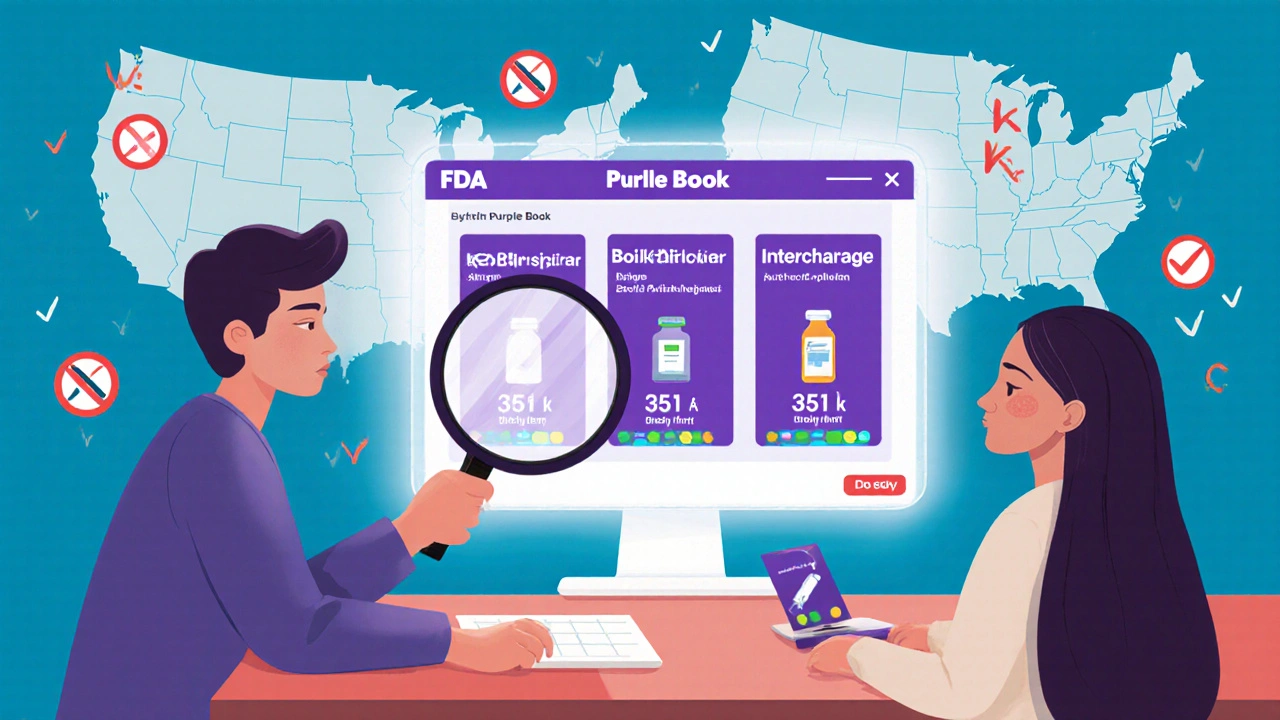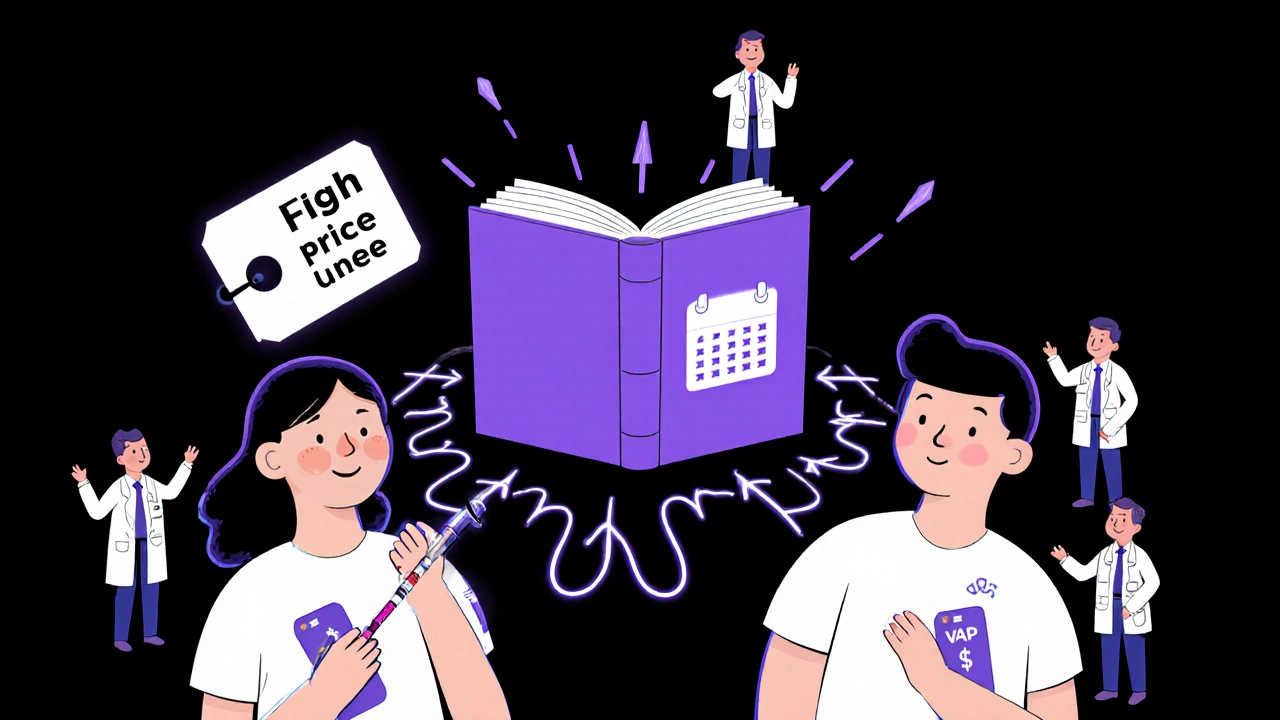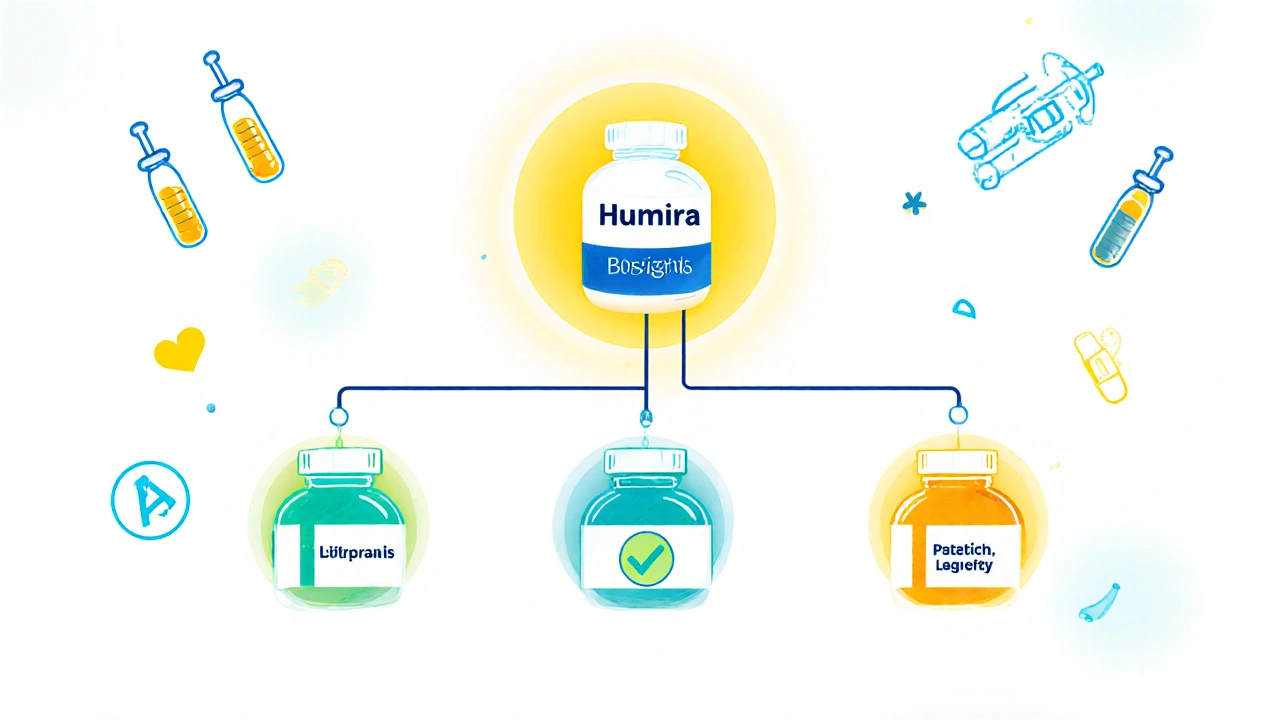The Purple Book isn’t a book you can hold in your hands-it’s a living, searchable database run by the FDA that tells you exactly which biological medicines are approved, which ones are biosimilars, and which ones can be swapped out like generics. If you’re a pharmacist, doctor, or just someone trying to understand why a biologic prescription might be filled with a different name but the same effect, this is your go-to resource.
What the Purple Book Actually Does
The FDA launched the Purple Book in 2012 after Congress passed the Biologics Price Competition and Innovation Act (BPCIA). Back then, it was split into two parts-one for drugs regulated by CDER and another for biologics handled by CBER. That made it messy. In 2020, they fixed it. Now, it’s one clean, searchable database that includes every FDA-approved biological product, whether it’s a reference medicine, a biosimilar, or an interchangeable product.
Think of it like a family tree for biologics. At the top is the original reference product-say, Humira or Enbrel. Below it, you’ll see all the biosimilars that have been proven to work the same way. And if one of those biosimilars has the extra stamp of “interchangeable,” it’s listed right under the reference with a matching color code. That visual system helps you spot connections fast.
The database doesn’t just list names. Each product card shows the approval date, whether it’s protected by exclusivity, and whether it’s been cleared for substitution. You’ll also see icons for delivery methods-autoinjectors, pre-filled syringes, vials-so you know what form it comes in. This isn’t just for regulators. Pharmacists use it daily to make sure they’re dispensing correctly.
Biosimilar vs. Interchangeable: The Key Difference
Not all biosimilars are created equal. A biosimilar is a biological product that’s highly similar to its reference medicine. The FDA requires proof that there are no clinically meaningful differences in safety, purity, or potency. That’s a high bar. But being a biosimilar doesn’t mean you can automatically swap it in at the pharmacy.
An interchangeable product goes further. It has to prove that switching back and forth between the biosimilar and the original reference product doesn’t increase risk or reduce effectiveness. That means clinical studies where patients get the reference drug, then switch to the biosimilar, then switch back-and repeat. The results have to show no drop in outcomes, no new side effects, no loss of control over the disease.
Here’s the catch: every interchangeable product is a biosimilar, but not every biosimilar is interchangeable. The FDA doesn’t say one is better or safer than the other. It just says interchangeable products have passed an extra layer of testing for repeated switching.
Why Interchangeability Matters at the Pharmacy
Pharmacists can’t just swap a biologic for a biosimilar unless it’s labeled interchangeable-and even then, state laws get in the way.
As of 2023, 47 states and Puerto Rico allow pharmacists to substitute an interchangeable biosimilar without asking the doctor first. But some states require the pharmacist to notify the prescriber, inform the patient, or fill out paperwork. A few states still require the prescriber to specifically write “dispense as written” on the prescription to block substitution.
This patchwork of rules creates confusion. A patient in Texas might get an interchangeable biosimilar automatically. The same patient in New York might get the brand-name drug unless their doctor says otherwise. The FDA’s Purple Book tells you what’s federally approved-but it doesn’t tell you what your state allows.
That’s why pharmacists check the Purple Book before making any substitution. They don’t rely on brand names or packaging. They look at the official designation: 351(a) for the reference, 351(k) biosimilar, and 351(k) interchangeable. That’s the legal language that matters.

What’s in the Purple Book Right Now
As of late 2023, seven biologics had received the interchangeable designation from the FDA. Two of them are insulin products-critical for people with diabetes who need affordable, reliable treatment. Three are used for autoimmune conditions like rheumatoid arthritis and Crohn’s disease. Two are for eye conditions affecting vision in older adults.
These aren’t theoretical. They’re being used. And more are coming. Companies are actively submitting applications for interchangeability, especially for high-cost drugs where savings could be huge. The FDA is also updating its guidance on labeling to make sure the names and information on the packaging don’t mislead patients or providers.
The Purple Book is updated regularly. New products appear. Exclusivity periods end. Designations change. You can search by brand name, generic name, or manufacturer. The results can be long, but the filters help. You can sort by approval date, product type, or interchangeability status.
What the Purple Book Doesn’t Tell You
It won’t tell you how much a drug costs. It won’t tell you if your insurance covers it. It won’t tell you whether a pharmacy has it in stock. And it won’t override state laws.
It also doesn’t list “unbranded biologics.” The FDA considers those equivalent to brand-name products, but they’re not interchangeable biosimilars. That’s a legal gray area. The Purple Book sticks to what’s officially approved under the BPCIA.
Some people think interchangeable means “better.” It doesn’t. It just means it’s been tested for switching. A non-interchangeable biosimilar works just as well in most cases. The difference is in the pharmacy, not the patient.

How to Use the Purple Book
Go to the FDA’s website and search for “Purple Book.” You’ll land on the searchable database. Start with the reference product you’re familiar with-say, Enbrel. Click on it. Below, you’ll see all biosimilars approved to match it. If any have a green checkmark or a special label saying “interchangeable,” that’s your signal.
Click on those biosimilars. You’ll see their approval dates, the studies they passed, and whether they’re approved for the same conditions as the original. Look for the 351(k) designation. That’s the legal marker.
Pharmacists use this daily. Doctors use it when they’re unsure about substitution. Patients can use it to ask informed questions: “Is this the same as what I was prescribed? Can it be swapped?”
The Bigger Picture
The Purple Book is part of a larger effort to make biologics more affordable without sacrificing safety. Biologics used to cost tens of thousands a year. Biosimilars have cut those prices by 15% to 35% in many cases. Interchangeable products could drive that even lower by allowing automatic substitution.
But progress depends on clarity. If pharmacists don’t know which products can be swapped, or if state laws make it too complicated, patients won’t benefit. The Purple Book is the foundation. It’s the official record. What happens next-how it’s used, how states adapt, how insurers respond-is up to the system.
For now, it’s the most accurate, up-to-date source for knowing what’s approved, what’s interchangeable, and what you can expect when your biologic prescription is filled.
Is the Purple Book the same as the Orange Book?
No. The Orange Book lists approved generic drugs and their reference brand-name counterparts. The Purple Book does the same thing, but only for biological products-complex molecules made from living cells, not simple chemical compounds. They’re different categories of medicine, with different approval rules.
Can a pharmacist substitute a biosimilar without my doctor’s permission?
Only if it’s labeled as interchangeable AND your state allows it. Even then, some states require the pharmacist to notify you or your doctor. Always check your state’s pharmacy laws. The FDA says it’s okay-but your local pharmacy has to follow state rules.
Are interchangeable biosimilars safer than regular biosimilars?
No. The FDA says interchangeable biosimilars aren’t safer or more effective. They’ve just been tested more rigorously for what happens when you switch back and forth between them and the original drug. Both types are equally safe and effective for treating the condition they’re approved for.
How often does the FDA update the Purple Book?
The FDA updates the Purple Book monthly. New products are added as they’re approved. Designations change when exclusivity expires or when new interchangeability determinations are made. It’s a live database, not a static list.
Can I use the Purple Book to find cheaper biologics?
Yes. If your doctor prescribed a brand-name biologic, you can search the Purple Book to see if there’s an approved biosimilar or interchangeable version. That doesn’t guarantee your insurance will cover it, but it gives you the name to ask about. Many biosimilars cost significantly less than the original.
What does the 351(k) designation mean?
It means the product was approved under section 351(k) of the Public Health Service Act-the legal pathway for biosimilars and interchangeable biologics. It’s how the FDA tells you this isn’t the original drug, but a version that’s been proven to work the same way.
Do biosimilars have the same side effects as the original?
Yes. The FDA requires proof that there are no clinically meaningful differences in safety. Side effects listed on the label of a biosimilar must match those of the reference product. If you’ve had side effects with the original, you might experience the same with the biosimilar.
Why aren’t more biologics interchangeable?
Because proving interchangeability requires extra clinical studies-switching patients back and forth between the biosimilar and the original. That’s expensive and time-consuming. Companies only pursue it if they believe they can win market share through automatic substitution. For some products, it’s not worth the cost.


Comments
luke young
Just found out my insulin is now interchangeable - this is huge for people like me who’ve been paying $500 a month for years. The Purple Book saved me a ton of stress and cash.
Thanks for explaining it so clearly.
November 25, 2025 at 11:18
james lucas
man i had no idea the purple book was even a thing until i read this
like i thought biosimilars were just cheaper versions but turns out theres this whole legal tier system with interchangeable and non-interchangeable and i was just using whatever my pharmacy gave me
now im gonna start checking the purple book before i fill any biologic script
also i think i spelled purple wrong like 3 times in this comment lmao
but seriously this is the kind of info that should be on every pharmacy flyer
November 26, 2025 at 15:31
Jessica Correa
So many people think interchangeable means better but it just means it can be swapped without a doctor’s okay
and honestly that’s all most of us need
the science is solid either way
just wish more pharmacists would explain this to patients instead of just handing out the brand name
November 28, 2025 at 14:38
Michael Fitzpatrick
It’s wild how much complexity is hidden behind something as simple as a prescription refill
the fact that there’s a whole federal database tracking every biosimilar and interchangeability status like a living family tree
and then state laws come in and make it a patchwork quilt of rules
some states let pharmacists swap automatically others make you fill out forms like you’re applying for a loan
the FDA did their part
now it’s up to states and insurers to stop making it harder than it needs to be
patients shouldn’t have to become pharmacologists just to get their medicine
November 29, 2025 at 21:14
Julie Pulvino
I’m a pharmacist and I use the Purple Book every single day
it’s not perfect but it’s the most reliable source we have
we don’t rely on brand names or packaging - we look for the 351(k) designation
and yes, the interchangeable ones get that green checkmark
but honestly? Most of the time, even non-interchangeable biosimilars work just fine
the real issue is insurance and state laws
if your state requires notification or prior authorization, it’s a nightmare to navigate
the Purple Book gives us the facts
but it doesn’t fix the bureaucracy
November 30, 2025 at 18:56
Patrick Marsh
Interchangeable ≠ better. Non-interchangeable ≠ worse. The FDA is clear. State laws are messy. Always check.
December 1, 2025 at 11:05
Danny Nicholls
OMG I just checked the Purple Book and found a biosimilar for my RA med that’s 60% cheaper 😱
and it’s interchangeable too!!
my pharmacist didn’t even mention it
but now I’m gonna ask every time
also if you’re a patient - DO THIS
it’s free and it could save your life (and your bank account) 💸🩺
December 2, 2025 at 04:17
Robin Johnson
Most patients don’t realize they have options. The system doesn’t make it easy - but the Purple Book gives you the power to ask the right questions.
Don’t just accept what’s handed to you.
Ask: Is this interchangeable? Is there a biosimilar? What’s the 351(k) status?
That’s how you take control of your care.
Knowledge isn’t just power - it’s savings.
December 2, 2025 at 16:57
Daniel Jean-Baptiste
Canada has a similar system but its not as public
we have the drug database but you need to be a health pro to navigate it
the purple book is way more user friendly
and i love that they use color codes
simple visual cues help so much
even if you dont know the science you can see the connection
good job fda
December 2, 2025 at 18:06
Rahul Kanakarajan
Why are we even talking about this? Biosimilars are just knockoffs. The original drugs work better. This whole system is just a pharma scam to cut costs. You think switching back and forth is safe? Please. People get worse. The FDA is too eager to approve anything these days. Wake up.
Also, why are you letting corporations control your health?
December 4, 2025 at 10:46
New Yorkers
Look. The Purple Book is the only thing standing between you and the corporate machine.
Every biosimilar is a tiny rebellion.
Every interchangeable label is a middle finger to Big Pharma’s price tags.
And yet - we still live in a country where your state decides if you can get cheaper medicine.
That’s not healthcare.
That’s a lottery.
And the FDA? They’re just trying to keep the lights on while the whole system burns.
Read the Purple Book.
Then scream into the void.
Then do it again tomorrow.
December 5, 2025 at 13:12
David Cunningham
Love that the FDA made this public and searchable - so many countries still treat this like a secret club.
Down under we’re still catching up, but seeing how transparent the US system is? Inspiring.
Hope more countries follow suit.
Also, the insulin ones? Huge win for diabetics everywhere.
December 7, 2025 at 01:45
manish chaturvedi
In India, biosimilars are already the norm - we’ve been using them for over a decade for cancer and autoimmune diseases.
But we don’t have a system like the Purple Book.
It’s a shame - because transparency saves lives.
What the FDA has built here is not just a database - it’s a model for global access.
Patients everywhere deserve to know exactly what they’re getting.
Thank you for making this public.
December 8, 2025 at 19:42